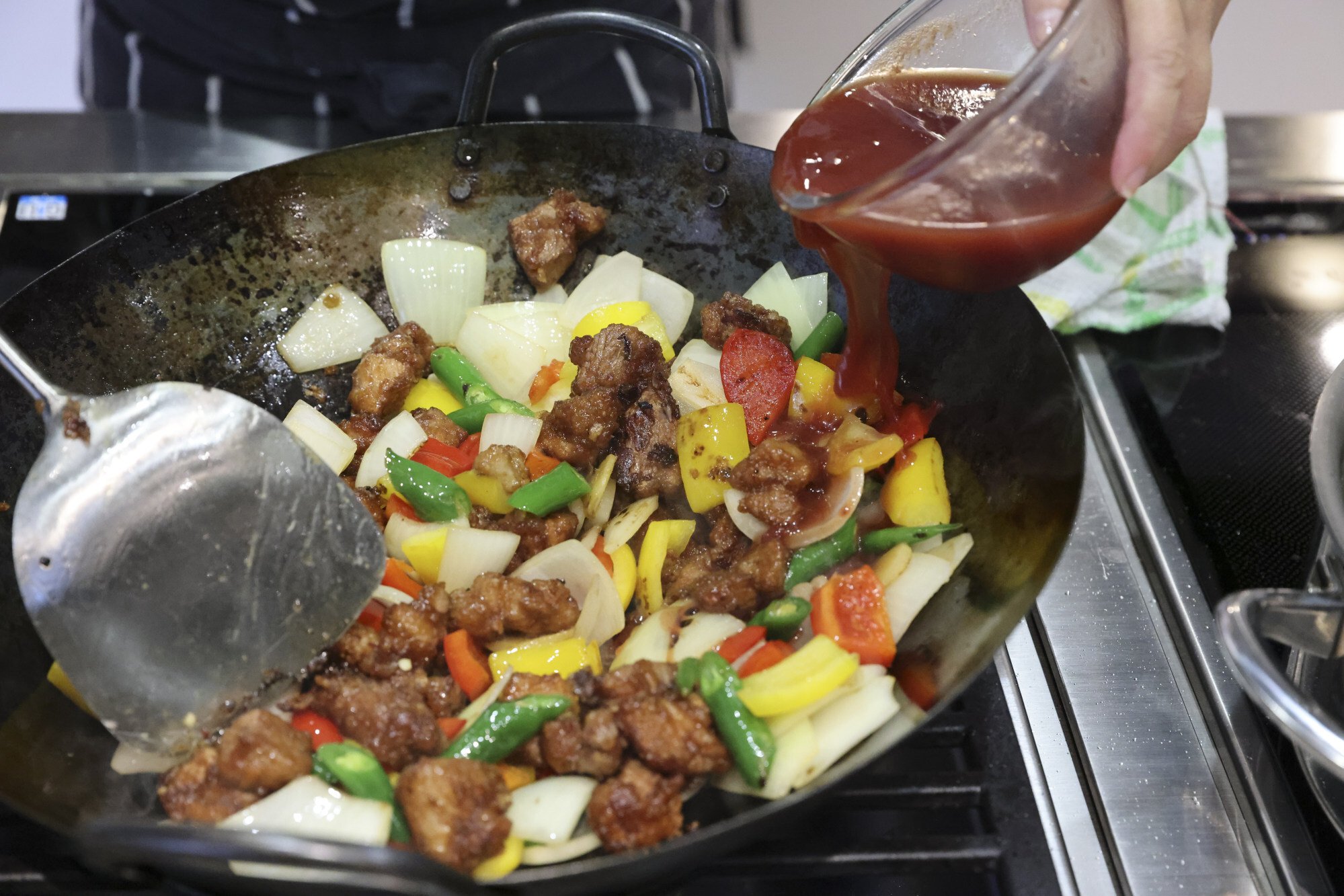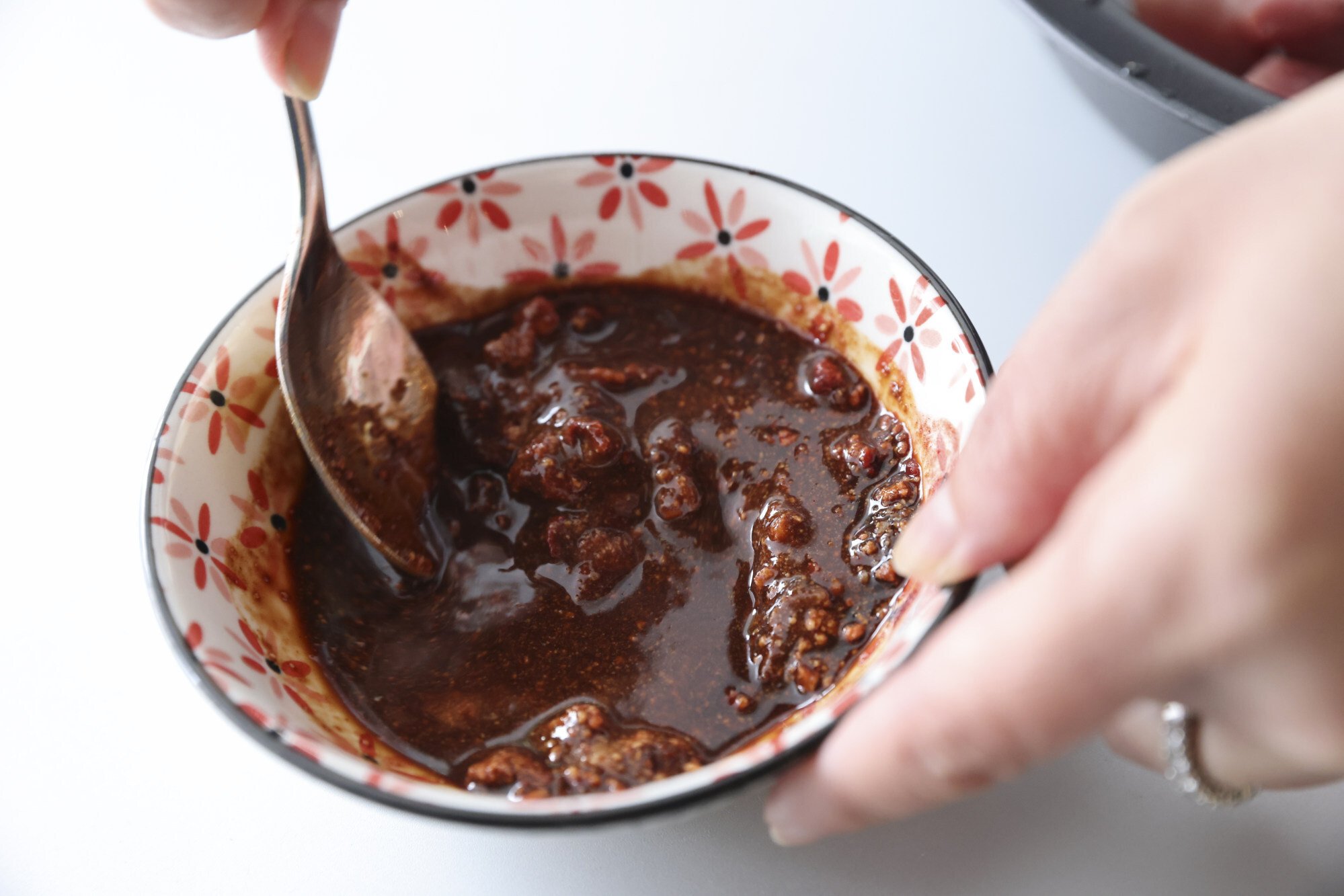
How to make strawberry sweet and sour pork, a Chinese favourite with a fruity twist, and strawberry jam
- There are many ways to make sweet and sour sauce; this one uses strawberry jam for the sweet and rice vinegar for the sour
- Thai tempura powder works well to coat the pork, and this recipe shows you how to make your own
The popular Chinese dish of sweet and sour pork is different depending on where you eat it. At an inexpensive dai pai dong, you’ll probably be served pork chunks in a sauce where the dominant flavours are ketchup and white vinegar, while at white-tablecloth restaurants the dish will be a lot more refined.
Contrary to what many people expect, sweet and sour pork isn’t always a bright reddish-orange; in Shanghai, for instance, the meat is coated in a rich, sticky, dark brown sauce.
Strawberry sweet and sour pork
Please don’t think this is some kind of outrageous, modern interpretation of the “traditional” Cantonese sweet and sour pork – because what is traditional anyway? I’m sure that when the dish was created, the chefs didn’t use ketchup, which is widely accepted now. Sweet and sour pork using strawberry jam as the sweet element has been around for at least 30 years, probably longer.

This version of sweet and sour pork doesn’t take much longer than the ketchup-and-vinegar one. I had to test the recipe many times before I was satisfied with it, and, surprisingly, the sauce was the easy part – it was the coating I had trouble with. Gogi powder – an excellent Thai tempura powder – works well, but depending on the country you are in, it might not be easy to find.
Fortunately, Gogi lists the ingredients – with bakers’ percentages – on the packet, so I adapted the formula. If Gogi tempura powder is available where you are, use it instead of the home-made version.
The amount of vinegar and pineapple juice you use will depend on the sweetness of the strawberry jam. I use home-made jam with a 4:3 fruit-to-sugar ratio. If the jam you use is sweeter, then you will need to use more of the sour ingredients to balance it.
You should also adjust the amount of pineapple juice and vinegar to suit your tastes. If the jam you use has large chunks of fruit, purée the sauce ingredients instead of just stirring them together.
Nam yu is a red fermented bean curd, sold in jars.

-
500 grams (18 oz) pork collar or skinless pork belly
-
30 grams (1 oz) nam yu (red fermented bean curd), drained
-
15ml (1 tbsp) light soy sauce
-
10ml (2 tsp) rice wine
-
¾ tsp granulated sugar
-
½ tsp fine sea salt
-
¼ tsp finely ground white pepper

-
2 large garlic cloves, peeled
-
3-5 peeled ginger slices, depending on size
-
1 onion, peeled, about 250 grams (9 oz)
-
1 each red and yellow bell pepper, about 300 grams (10½ oz) in total
-
2-3 long, slender, mild green chillies
-
6-8 fresh strawberries, plus extra for the garnish
-
1 large egg
-
Cooking oil, as necessary
For the sauce
-
120 grams (4 oz) strawberry jam, home-made or bought
-
60 grams (2 oz) tomato purée
-
60ml (¼ cup) unsweetened pineapple juice
-
45ml (3 tbsp) rice vinegar
For the home-made tempura powder
-
150 grams (5 oz) plain flour
-
15 grams (2 tbsp) tapioca starch
-
5 grams (1¼ tsp) baking powder
-
½ tsp fine sea salt

1 Cut the pork into one-bite pieces and put them in a bowl.
2 In a small bowl, mix the nam yu with the soy sauce, rice wine, sugar, salt and white pepper. Pour this over the pork and mix well, then leave at room temperature for at least 45 minutes.

3 Halve the garlic cloves, then thinly slice them. Stack the ginger slices and cut them into thin strips. Halve the onion, then cut it into one-bite pieces. Remove and discard the stem and seeds from the bell peppers. Cut the bell peppers into thin strips. Slice the chillies on the diagonal into pieces about 1.25cm (½ inch) long. Put all the ingredients in a bowl.
4 Trim off and discard the stems of the strawberries, then slice the fruit in halves or quarters, depending on size.
5 In a medium-size bowl, mix the strawberry jam with the tomato purée, pineapple juice and vinegar (or purée the ingredients). Taste the mixture – it should be a balanced sweet-tart. Add more vinegar, if necessary.
6 Put the flour, tapioca starch, baking powder and salt in a bowl and use a whisk to combine thoroughly.
7 Crack the egg into the bowl holding the pork and mix thoroughly. Add 60 grams (2 oz) of the home-made tempura powder and mix well. Put the remaining tempura powder into a flat dish.
8 Pour about 500ml (2 cups) of cooking oil into a wok placed over a medium-low flame (you will probably need more oil if it is a flat-bottomed wok). Heat the oil to 160 degrees Celsius (320 degrees Fahrenheit).

9 While the oil is heating, dredge about one-quarter of the pork pieces in the tempura flour to coat them lightly but thoroughly, then shake off the excess flour. Add the pieces one by one to the hot oil and fry them for about three minutes, or until fully cooked, stirring often. Use a flat mesh sieve to lift the pieces out of the oil, then drain them on paper towels. Cook the remaining pork pieces the same way.
10 After frying all the pork, turn the flame under the wok to medium and heat the oil to 180 degrees Celsius (350 degrees Fahrenheit). Add half the pork pieces to the hot oil and cook for about one minute, stirring often. Lift the pork pieces out of the wok, then drain them on paper towels. Refry the remaining pork the same way. Pour off as much oil as possible from the wok (no need to wash it).
11 Place the wok over a medium-high flame and pour in 10ml (2 tsp) of fresh cooking oil. Put the garlic, ginger and all the vegetables into the wok. Stir-fry for about a minute, or until the vegetables are crisp-tender. Transfer the vegetables to the bowl that originally held them.
12 Place the wok over a medium flame. Stir the strawberry/vinegar mixture, then add it to the wok and bring to a simmer. Cook for about 30 seconds, then add the vegetables and stir well. Bring back to a simmer.

13 Add the pork to the wok and stir well, then mix in the fresh strawberries. Stir for about 45 seconds, or until the pork is lightly coated with the sauce. Transfer the ingredients to a serving dish, then garnish with more strawberries, if desired. Serve immediately.
Strawberry jam
I make this jam with frozen fruit, because fresh strawberries are expensive in Hong Kong.
-
1kg (2lb 3oz) frozen strawberries, thawed
-
750 grams (27 oz) granulated sugar, divided
-
75ml (¼ cup and 1 tbsp) fresh lemon juice
1 If the strawberries are large, cut them in halves or quarters. Put the strawberries in a large bowl and add 500 grams (18 oz) of sugar. Mix well, then leave at room temperature for about two hours, stirring frequently. Refrigerate the mixture overnight.
2 The next day, pour the strawberries and sugar into a colander placed over a large pot. Let the juice drain into the pot, then place the colander (with the strawberries) back over the bowl used to macerate them.
3 Add 250 grams (9 oz) of sugar to the strawberry juice in the pot. Place the pot over a high flame then stir until the sugar dissolves. Simmer for five minutes, stirring often, and taking care that the mixture doesn’t boil over and spill over the pot.
4 Add the strawberries to the pan, bring to a boil, then simmer for two minutes, stirring often. Turn off the flame and leave for 15 minutes.
5 Bring the mixture to a boil, then simmer for two minutes, stirring often. Turn off the flame and leave for 15 minutes. Repeat this one more time.
6 Bring the ingredients to a boil, then simmer, stirring constantly, until the mixture reaches the setting point. Test by putting a spoonful of the mixture onto a cold plate. Draw your fingertip through the jam – it should leave a track mark before filling in slowly.
7 Stir in the lemon juice, then ladle the mixture into heatproof jars – you will need four that hold 250 to 300 grams (9 oz to 10 oz) each. Screw the lids on the jars, then cool to room temperature. Store the jam in the fridge.
Food styling: Nellie Ming Lee. Kitchen: courtesy of Wolf at House of Madison

